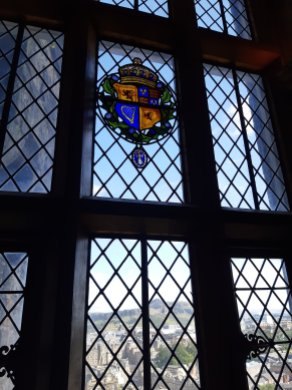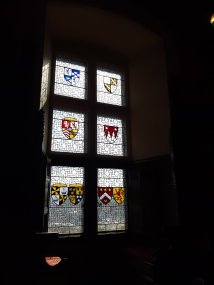Here is the second part to my recount of our Edinburgh trips, the first part is here: Edinburgh – part 1. This post is more outdoors, but just as cultural, and a little more historical:
Princes Street Gardens and Sir Walter Scott Monument
We walked through here whenever we could, right by Waverley train station, two separate parks right next to each other holding the Sir Walter Scott Monument, a gardener’s cottage, a lovely fountain, and a few cafes all under the shadow of Edinburgh Castle.

New Calton Burial Ground and Burns Monument
Here you can see Holyrood Palace, Arthur’s Seat, and Salisbury Crags. Such amazing views from here, nearby is the Burns Monument, and it was here that we saw a vehicle being prepared for a car chase scene for a film.
Arthur’s Seat and Salisbury Crags
We walked eastwards via the Meadows towards the foot of a dormant volcano. Looking online we saw that there were many routes to get up to the top, the first route we took would have led up to essentially a zig zag rocky ladder, so we walked around Hunter’s Bog towards the Palace of Holyrood and saw the ruined St Anthony’s chapel. We followed some people and walked up another path towards the summit, but this turned out to be very rocky as well, just not as steep. I think there was another path that we were meant take that was shallower but we missed this route. It was a struggle for me, that’s for sure, I was very tired when we got to the top.
We reached a rocky flat part for a break and had a little picnic overlooking some wonderful views. We were mindful that there were no bins here. We then continued to walk up to Nether Hill, where there was beautiful green grass, and even saw a dog up here. Here you can see Edinburgh Castle, Holyrood Palace, and Salisbury Crags, we could see people walking along the crags. It was very windy up here! We then went down towards Dunsapie Loch, a gradual gradient going downwards. We then walked around towards Holyrood Palace, where behind it is the Education Centre which was the nearest public restrooms, naturally there are no facilities at the top.


Palace of Holyrood House
I loved this place. We bought tickets online and printed them ready so we skipped the queues. Audio media guides are provided along with your ticket, which were really good and informative both visually and audially. The guide takes you along two floors and is really easy to follow. We walked up the grand staircase and followed the procession where you get closer to the sovereign: starting with larger state rooms, leading to smaller private rooms that are more elaborately decorated, and then finally the bedchambers. From here onwards you cannot take pictures.
The Dining Room was quite spectacular, where royalty still dine today, it was first turned into a dining room towards the end of Queen Victoria’s reign. You also get to see the Throne Room, which is now used for receptions and state occasions. The largest room was the Great Gallery where, naturally, many portraits of monarchs are hung. Banquets are held here and every year the Queen honours people in this very room. Some paintings have been restored as English soldiers slashed them with their swords after a defeat against the Jacobites centuries ago.
Bonnie Prince Charlie spent six weeks at Holyrood Palace during the Jacobite uprising and there are a couple of little rooms about him. Up on the second floor is Mary Queen of Scots’ bedroom and her treasures. Here, Queen Mary’s private secretary was murdered by her second husband and several lords. Further along the tour there was also an exhibition of the royal wedding where the wedding outfits of the Duke and Duchesss of Sussex are on display, along with the outfits of Prince George and Princess Charlotte.

After leaving the palace you are led to Holyrood Abbey, where you can take pictures again. The ruined church nearby is where Margaret (Henry VIII’s sister) got married when she was 15. Next to this are the beautiful gardens, where royal events are still held and you can see the foundations of parts of the abbey that no longer exist.
Edinburgh Castle
When we visited this castle the seats for the Tattoo were still being taken down so we weren’t able to enjoy the views looking down from right outside the castle gates. When we previously visited Edinburgh Castle during Halloween it was so cold and windy but worth it for the views. We found this visit was very busy, with hoards of people, whilst previously we visited later in the day and there was practically no one around bumping into you.

We got tickets online, meaning we didn’t have to join the long queues. Audio guides are not included in the ticket price, but were useful and very informative. There are also guided tours every half hour or so too, which is included in the ticket price.
Near the gates you can see spectacular views down into the New Georgian Town. Here are also six cannons that were used to defend the castle during many civil wars, such as the Wars of Independence and when the keeper of the castle held it for Mary Queen of Scots when she was imprisoned. Nearby the firing of the 1 o’clock gun drew in a large crowd. This gun is fired at 1pm every day, except Sundays, Good Friday, and Chrismas Day. The reason why the gun is fired at 1pm instead of noon, according to the audio guide, is because one cannon is cheaper than 12.

Next we went upwards to St Margaret’s Chapel, the oldest building in Edinburgh, which was built by David I and named after his mother Queen Margaret who is said to have died from a broken heart after news that both her husband King Malcolm III and son Edward died in the Battle of Alnwick.
Outside the chapel sits Mons Meg, a massive 6 tonne cannon that was state of the art back then. Taking days to carry it for miles and only firing ten cannons a day, this beast was not efficient. Later used ceremoniously, such as when Mary Queen of Scots got married, its barrel burst when fired to celebrate a visit by James II/ VII.

Inside the Crown Square you can see the Stone of Destiny and the Honours of Scotland, as well as other treasures found in the chest where the jewels were rediscovered by Walter Scott. The Stone of Destiny was used for centuries in the inauguration of Scottish kings and in coronation ceremonies too. The Honours of Scotland include Britain’s oldest Crown jewels, as the English crown was destroyed by Oliver Cromwell, whilst these were hidden. The crown was made for James V, whilst Mary Queen of Scots was the first to be crowned with both the new crown and sceptre together. Nearby is the state apartments, including the room where James I/ VI was born, which is tiny. Outside the window of this room you can see Arthur’s Seat, but I imagine Mary Queen of Scots would have been too busy to enjoy this view.

Next we stepped into the Great Hall which was built for James IV (Henry VIII’s brother in law) for banquets and ceremonies, and was later converted into soldiers barracks by Oliver Cromwell, and then later reverted back to state and royal use. The stained glass windows show coat of arms and behind them great views.
The Scottish National War Memorial Church has a lovely garden. The stained glass windows show scenes from WW1 and animals represent vices whilst humans represent virtues.
We spent a good few hours listening to the rich history of this beautiful windy castle. There were other parts too, such as military museums and prisons of war exhibition. Very crowded, naturally, but definitely worth a visit.
Here are a few more pictures of views from Arthur’s Seat and Edinburgh Castle:





























One thought on “Edinburgh – part 2”